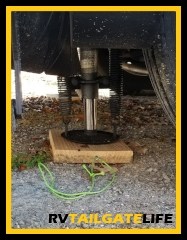Adding Permanent Jack Pads with RV SnapPads
One of the first steps of setting up your RV tailgate or camp site is to put the jacks down and level up.
But it is annoying to have to get out and put jack pads down under the jacks. Wouldn’t it be better to just press the button and let the jacks go down because you already had permanent RV jack pads installed?
Keep reading to find out about RV SnapPads and how you can get a special discount on your next order!
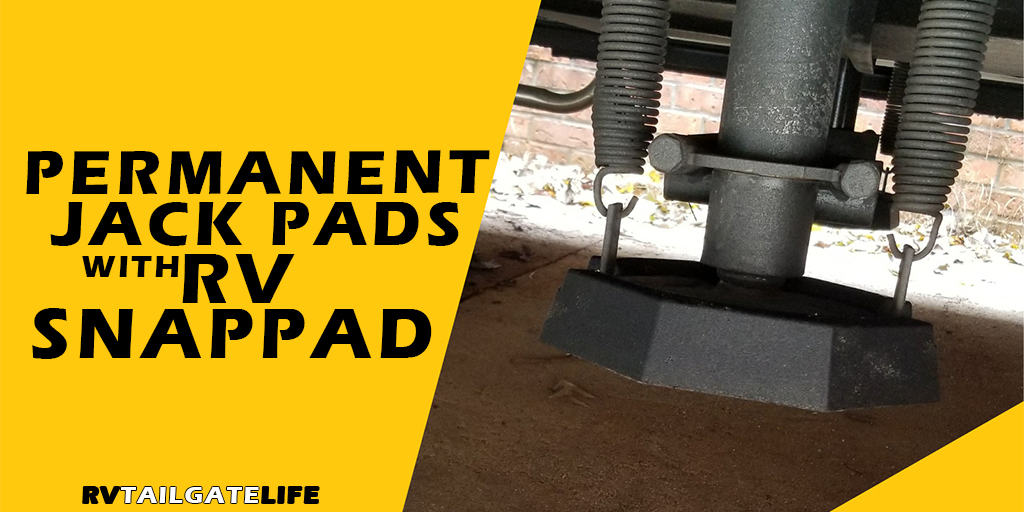
What RV Jacks Do
RV jacks extend from the body of your RV to touch the ground. These provide another point of contact with the ground other than the wheels.
There are two kinds of RV jacks – and the difference is important to know and understand.
Stabilizing RV Jacks
Stabilizing jacks are important in campers to support and literally stabilize the RV from movement inside the RV.
You know, the sway and annoyance that comes from walking around inside the RV. Or um, the more recreational fun for adults (don’t come a-knocking if the rig is rocking!) If you know, well, you know what I’m talking about.
Stabilizing jacks won’t eliminate all sway and movement, but they aren’t perfect.
Also, while they may help with leveling, stabilizing jacks should not be used to level your camper. You should rely on leveling jacks for that (see the next section) as well as blocks and other leveling methods. They aren’t built for leveling and you could end up with some pretty big disasters if you use them improperly.
Leveling RV Jacks
The other type of RV jacks are leveling jacks. They level your RV from front to back and side to side.
Leveling jacks are specifically designed to take on the heavy duty loads and weight of your RV. (Yet another reason not to overload your RV. It’s not just the tires but also the jacks that can be damaged when you go over the weight limits).
More Variations on RV Jacks
While there are two types of RV jacks, stabilizing and leveling, there are quite a few different common variations of these.
Many leveling jacks come with an automatic leveling option – a powered solution with an internal level to figure out when your camper is balanced. You can then manually adjust, while still using the power, to fine-tune or override the automatic setting.
Many of the stabilizing jacks also come with powered or manual options. For the manual options, I highly recommend a jack drill adapter so that you can use a cordless drill instead of manually cranking and thus wearing you out before the fun of tailgating and camping even begins!
If you are looking for an awesome cordless battery powered drill, I highly recommend the Ryobi Cordless Drill from Home Depot. I use the Ryobi line of tools in both my RV and my sticks and bricks house. Since I have so many of their tools, I have a lot of batteries that I can change out between the tools. And now, I can buy “tool only” instead of the tool + battery for new tools that I decide I just have to have.

Scissor Jacks are a type of stabilizing jacks that are common on trailers and smaller campers. They get the name from the way that they extend, as it looks like they are opening like a scissor.

Tongue Jack is used on trailers to support the front of the trailer, where it would otherwise hook up to your tow vehicle. These can be manual or powered, but powered is easier to setup.

The next kind of stabilizing jack is the Jack Stand that is also used on trailers. These typically have a wider base than other RV jacks which definitely helps with the stability.
There are a variety of jacks, and even manufacturers. Which means what works for some people may not work for you. Keep trying until you find the perfect combination of leveling and stabilizing jacks.
What are RV Jack Pads?
RV Jack Pads are items that you place between the jack and the ground.
Jack pads can be made of a variety of materials – wood and plastic being the most common. But rubber is also an option.
You can make your own RV Jack Pads out of wood. I’ve got wood jack pads as well as wood ramps to place under my wheels. But I have also installed permanent jack pads on my leveling jacks.
Why You Need RV Jack Pads
Since RV jacks are designed and intended to make contact with the ground, there’s a chance of two different mishaps happening. These are both closely related, but still distinct problems that happen when you don’t use jack pads.
Mishap #1: Jacks Sink Into the Ground
The first is that the RV jacks will sink into the ground. This is more common on grass fields after a rain. In other words, when you are putting the jacks down into mud.
You may start on solid ground, but after a good rain, the mud forms and your jacks sink. Oops!
When you go to raise the jacks when it is time to move on, the jacks can be stuck in the mud. A suction type event happens to keep the solid jack surface from being retracted.
When this happens, you may have to get down on the ground so you can help the jacks up. If you are lucky, you’ll have a long piece of wood or metal that you can use to provide an air gap to break the suction and to provide leverage to help those jacks up.
RV jack pads help prevent this kind of mishap with RV jacks by providing a middle layer between your jacks and the muddy ground. The greater surface area also helps to prevent the sinking.
Mishap #2: Jacks Damage the Ground
When jacks are placed on asphalt, or even on grass, they concentrate a lot of weight onto a small surface area.
This can be a problem with jacks sinking into the ground too. But it also causes a similar problem on the other side.
This can be very damaging to the asphalt parking lots that we tailgate in. Even in fields of grass, the jacks can dig in and create holes and divots.
By using RV Jack Pads, you spread out the weight over a greater surface area to help protect the ground surface.
Now, jack pads and even SnapPads are not a guarantee against damage to parking lots. After all, there’s only so much space we can spread out the weight of a Big Rig RV. I’ve seen heavy rigs do some damage to parking lots just by driving on them (especially when the asphalt hasn’t completely cured yet).
But jack pads definitely decrease the likelihood of damage done by the jacks themselves.
What are SnapPads?
One of the problems with most RV jack pads are that they aren’t always on your RV jacks. You have to get out of the RV or your tow vehicle and get down on the ground to place your pads.
This is just so much fun when it’s raining. Or not!
That’s why I really like RV SnapPads, a permanent solution that stays on your RV jacks all the time.
You don’t have to worry about leaving these jack pads behind. You don’t have to get under the RV to place them each time you park. They are there and always ready.
Another side benefit – they are made with recycled tires. Which means they are environmentally friendly, keeping tires out of the landfills.
Special Discount on RV SnapPads
Do you want a special discount on RV SnapPads?
How does 10% off sound?
With the discount code KIMBERLY60334 you can get 10% off your order from RV SnapPads!
Using this link though, it should be automatically applied to your order! Just in case though, make sure to check on the checkout page that the code KIMBERLY60334 has been applied! You won’t see the discount until the checkout page, not the shopping cart page (just an FYI).
Installing RV SnapPads on a Motorhome
I’ve had SnapPads on my motorhome for a few years now and highly recommend them from personal use!
The most difficult thing was to get them installed… and it really wasn’t that difficult. The instructions were pretty clear.
But here are a few tips:
- You want to have two people for this job. One person that will get under the motorhome and one person to run the jacks from inside. Probably not as big of a deal if you have manual jacks, but definitely want that second person if the automatic jacks control is not mobile/is inside the motorhome like mine is.
- Get some regular old dishwashing soap. It’s good for lube. Well, lube for SnapPads not for other purposes.
- Keep your fingers out of the way of your jacks.
- Start with the bottom of your jacks clean of any dirt or debris. Wipe them off and even hose them down if necessary. Otherwise you’ll be trapping the dirt on the bottom of the jacks in the SnapPad.
Installation Process
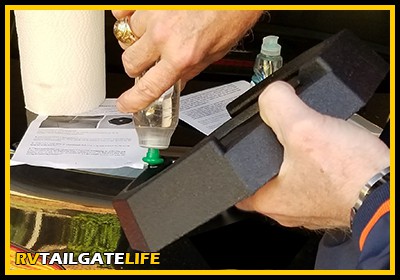
OK, now that you are ready to begin, put some dishwashing detergent around the lip of one SnapPad. You are going to install one SnapPad at a time. Don’t try to do all of them at one time.
One person is going to get on the ground to position the SnapPad directly below the jack.
The other person is going to be inside, running the jacks. You’ll want windows open and the radio off. Maybe even some walkie talkies so that you can talk to each other.
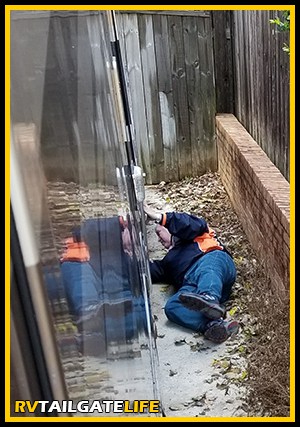
Once the ground person gives the OK (and their hands are not under or near the jack), you’ll want to manually lower the appropriate jack. As the jack lowers down, the ground person may tell the other to stop or keep going, depending on how accurately they placed the SnapPad.
The ground person will know when the jack is fully seated in the SnapPad when they hear a distinctive snap. (You didn’t think the creators of SnapPad were being all that creative when they named their product, did you?) Have the inside person raise the jacks to be sure.
Now repeat with all the other jacks on your rig.
Don’t Ditch Your Existing Jack Pads
Even though I have and love my SnapPads, there are times when the DIY wood jack pads still come in very handy.
And that’s when you are parking on unlevel/uneven ground. I use the wood to help extend the reach of my jacks when there’s too much distance to get the motorhome level.
In my new tailgate parking spot at GT, the driver’s side of the RV is much lower than the passenger side. I cannot get the driver’s side high enough without using some additional help from the wood blocks. So I use both the SnapPad and the blocks to get level.
I have found that the SnapPad helps keep those wood blocks in good shape longer though. Before I installed the SnapPad, I’d go through them in about a year’s worth of tailgating because of the concentrated pressure from the metal jacks. Now, I have only gone through one set, although they are still getting near the end of their lifespan.
Add RV SnapPads to your Jacks
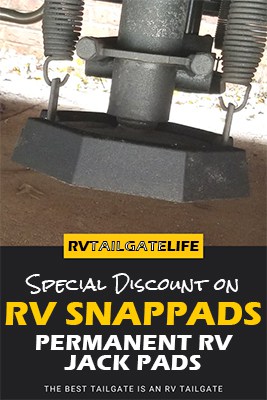
Don’t forget to use the discount code KIMBERLY60334 to get 10% off your RV SnapPads.
I’ve had them on my motorhome jacks for years now and really enjoy having them permanently attached. It makes for quicker setup on level(ish) parking spots.
Like RV SnapPads? Or buying later? Pin to remember to get your discount code!
You May Also Like:
10 RV Gadgets You’ll Wish You Had For Your Next Tailgate
Must Have RV Safety Gear
Essential Gear for RV Waste Tanks

